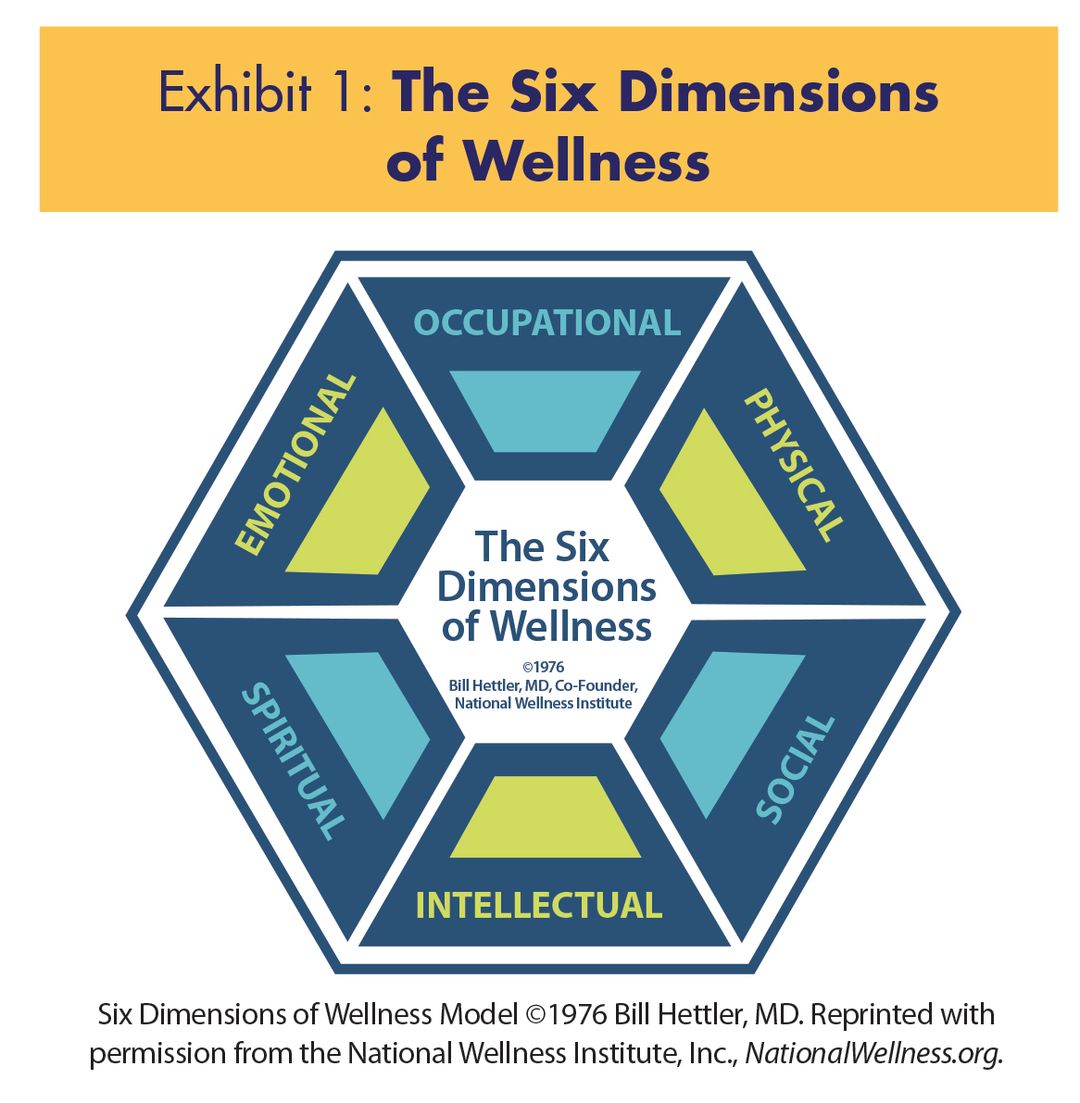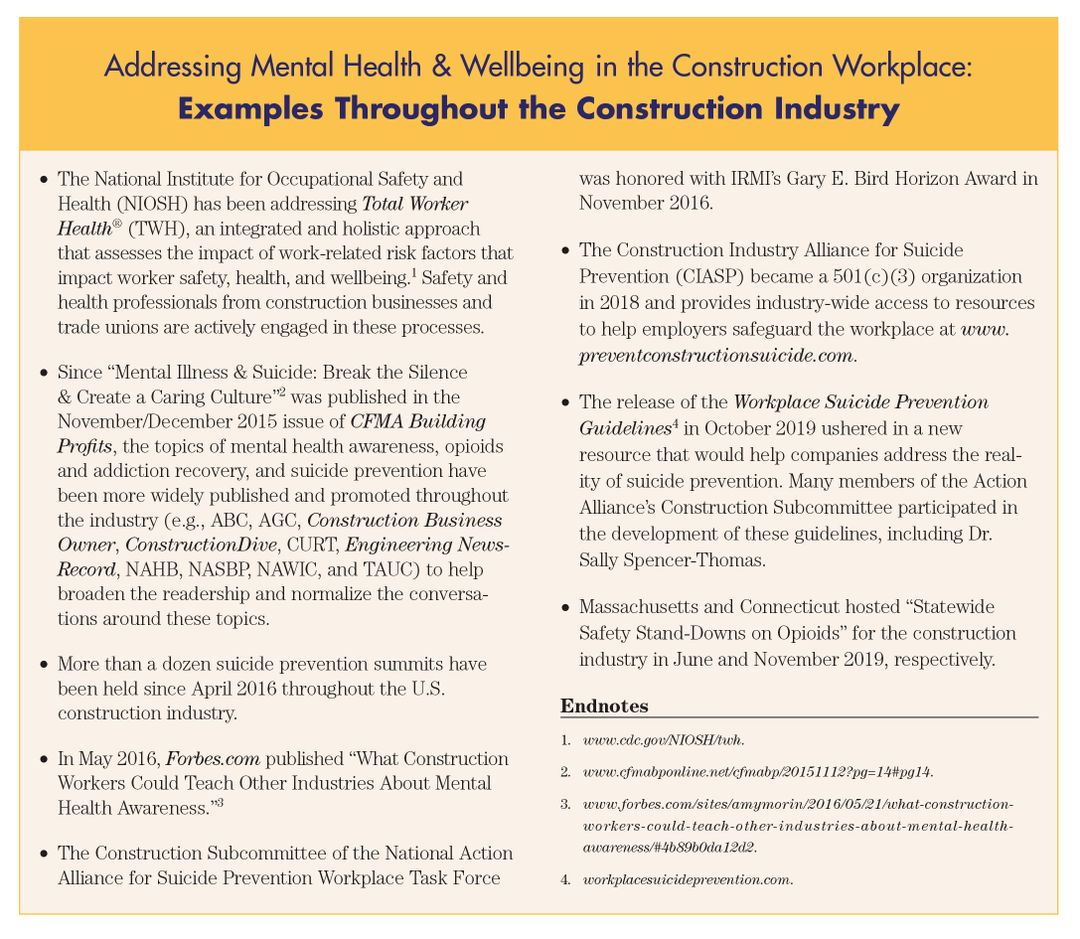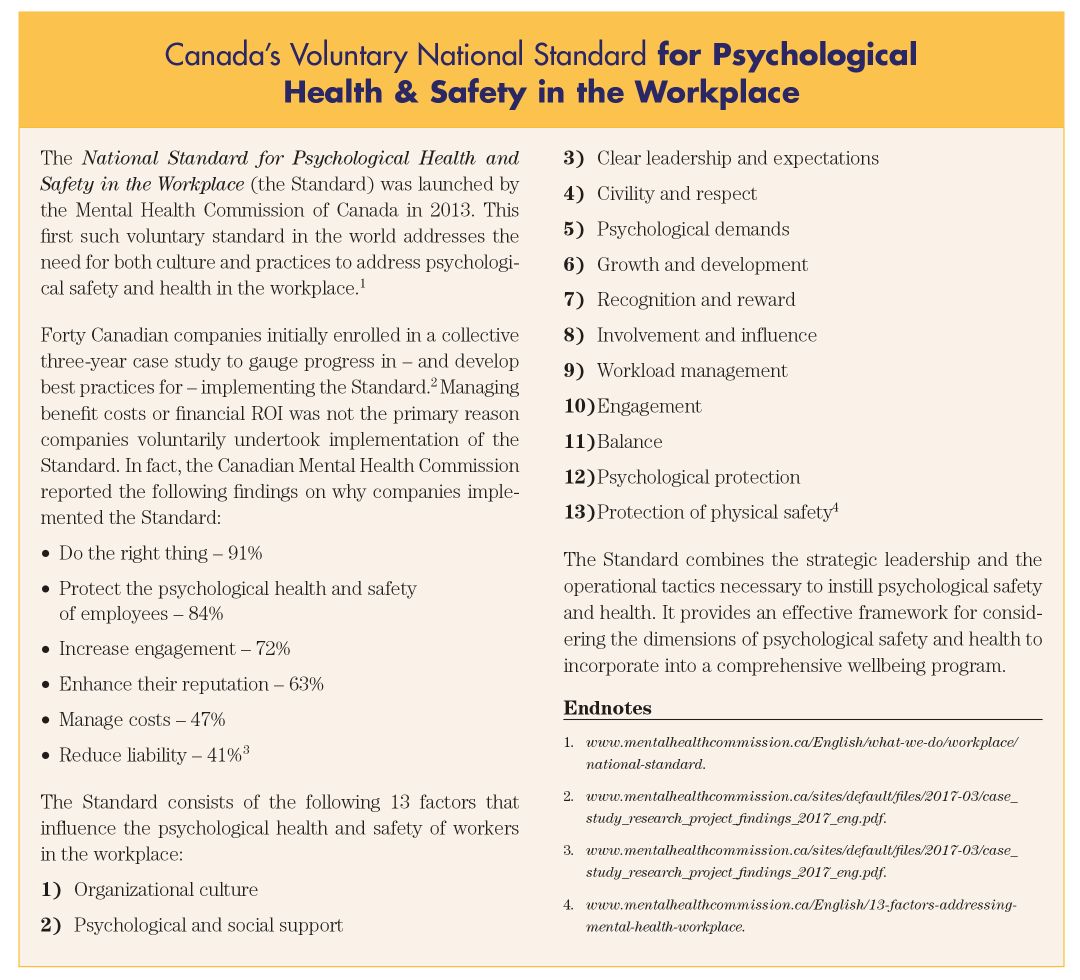Given the far-reaching effects of COVID-19 throughout the construction industry, it is imperative for business leaders to thoughtfully consider the short- and longterm impact on the mental health and wellbeing of their workforce. There is consensus among mental health providers that the effects of stress, anxiety, worries, and uncertainty spurred by COVID-19 will continue to affect the workforce well beyond the current pandemic.
Mental Health & Wellbeing Are Leadership Imperatives
The construction industry has had a mental health, substance use, and suicide problem well before COVID-19. But until recently, mental health was not openly addressed in the workplace. Beyond COVID-19, discussing and addressing mental health in the workplace will continue to grow in prevalence, helping to make this an easier topic to address. In the absence of concrete research on the impact of mental health in construction, it is appropriate to rely on the mental health and wellbeing practices that have been adopted throughout the industry. Many signs are pointing to the increasing acceptance and importance of addressing mental health in the construction workplace. (See "Addressing Mental Health & Wellbeing in the Construction Workplace".)
Investing in Employees
The mental health and suicide prevention initiative began in the human capital risk management platform in 2014. In 2015, “Leveraging Human Capital Risk Management” was published in CFMA Building Profits and posited that “a contractor’s most important resource, and one of its leading costs, is its employees. By actively investing in employee, supervisory, and leadership development programs, CFMs can expect a positive ROI and other measurable outcomes in both its risk management and human capital investments. This intentional strategy combines organizational development practices to leverage human capital risk management and protect a company’s bottom line.”1


Caring for Employees
In the post-coronavirus business world, demonstrating a caring culture for employees will be both an expectation and an imperative. MetLife reported in 2015 that 68% of employees believe “employers have a responsibility for the health and wellbeing of their employees,” which grew to 76% in 2019.2 Moreover, according to PwC’s Health and Well-being Touchstone Survey Results, wellbeing needs to focus beyond physical wellbeing as a “holistic wellness program that target[s] physical, mental, and financial wellbeing and improve[s] morale, enhance[s] culture, and reduce[s] burnout.”3
Workplace Empathy
While empathy has been seen as a key to making employees feel supported in the workplace, the 2020 State of Workplace Empathy reveals that businesses in the U.S. have more progress to make in this area. There is a pronounced gap between how company executives perceive the performance of their organizations in empathetic practices vs. how employees report the companies’ execution of empathy. Specifically, 86% of CEOs believe that their companies discuss the importance of mental health with their employees; however, only 58% of employees feel the same way.4
Return on Investment
In recent years, “companies’ mental health expenses have risen more than 10% annually compared with increases of 5% for other medical costs.”5 Moreover, research by Milliman reported that “if employees have physical illnesses, coupled with a mental health or substance use issue, the costs for treating them is two to three times higher than for those employees with a physical illness alone.”6
There is growing proof that a business can financially benefit from investments in mental wellbeing. Mental Health America reports in the Mental Health Support Guide that “for every $1 spent on mental health care, a company will receive a $4” ROI.7
The Centre for Economic Performance conducted a meta-analysis using Gallup data from independent research studies that include observations on the wellbeing of 1,882,131 employees and performance of 82,248 business units, and found that “employee wellbeing is consistently positively correlated with firm performance.”8 The authors noted that they “focus on the financial, retail, manufacturing, and service sectors because we had fewer than 20 studies for the remaining sectors (materials and construction, personal services, real estate, and transportation and utilities), which we deem insufficient to base inference on.” They concluded that the evidence suggests “a strong, positive relationship between employee wellbeing, employee productivity, and firm performance.”9
Developing a Construction Industry Wellbeing Model
Concern for addressing mental health in the construction workplace is on the rise, but the reality is that costs and consequences of mental health concerns in construction are understudied.
Before the introduction of a construction-specific wellbeing model, two models existed at the individual worker level.
National Wellness Institute’s Six Dimensions of Wellness
The National Wellness Institute (NWI) created the Six Dimensions of Wellness (Exhibit 1) in 1976. This holistic model integrates various dimensions of personal life to identify the six factors that contribute to wellness and fulfillment: occupational, physical, social, intellectual, spiritual, and emotional. The NWI offers a certification in wellness, various certificate programs in health, resilience, and wellness and is also an authorized continuing education provider for the National Board for Health and Wellness Coaching.
Gallup’s Wellbeing Model
Gallup, a recognized leader in surveys, data analytics, and insights relating to engagement and wellbeing, has researched the direct impact on business outcomes of how employees rate the five interrelated elements of wellbeing – physical, career, social, financial, and community – in their personal lives. Wellbeing and engagement are two related factors identified by Gallup that directly influence business results.10
Construction Wellbeing Model
The Construction Wellbeing Model (Exhibit 2) was created to provide a framework for developing and implementing a tactical wellbeing strategy in construction companies.
This holistic and integrated model consists of wellbeing tools, strategies, and outcomes.
The construction industry workforce is less uniform or homogeneous when compared to other industries (i.e., financial services, retail, and service sectors). Construction companies have a split between salaried office employees and hourly field employees. For union contractors, labor unions generally provide health and other welfare benefits.
This construction wellbeing model focuses on strategies that address wellbeing initiatives and services for the workplace, workforce, worker, worksites, work tasks, and work groups.

Action Steps to Institute a Strategic Framework that Addresses Mental Health & Wellbeing
Here are some steps to help integrate mental health and wellbeing into your company culture:
- Institute a collective mindset for wellbeing as a part of a respectful workplace committed to equity and social justice. This mindset should also accept mental health as a diversity and inclusion opportunity.
- Recognize the unique challenges to mental health and wellbeing among the construction workforce, which includes U.S. Veterans, National Guard Reservists, workers with frequent shift changes and recurring overtime, and employees with underlying mental health conditions.
- Build a caring culture that embraces wellbeing by incorporating mental health awareness, substance use and addiction recovery, and suicide prevention into safety, health, wellness, employee benefits, and employee/labor relations.
- Promote psychological safety and health by frequently communicating with empathy to employees regarding senior leadership’s concern about mental health in the workplace.
- Verify if your company has an employee assistance program (EAP). If your company does not have an EAP, commit to instituting one to help address the needs of all employees. Consider renaming – or at least promoting – the EAP to an employee and family assistance program (EFAP) to expand awareness that this benefit extends to dependent family members.
- If your company does have an EAP, check your program’s utilization rate and the types of services that are accessed by your employees. This confidential report can help you identify ways to increase the use of your EAP program, such as:
- Communicating the eligibility of work/life balance and behavioral health services available through the EAP.
- Instituting managerial, supervisory, and employee training to educate your entire workforce about the purpose, features, and benefits of the EAP.
- Deploying proactive communication strategies, including sharing various modes of access, to promote use of the EAP.
- Including information about the EAP in your new hire orientation packet, open enrollment packets, and informational sessions about health and other employee benefit programs.
- Union contractors are encouraged to inquire with the unions’ local business managers to understand the behavioral health services and medical health benefits available through the unions’ health and welfare funds. Inquire if the union has an EAP or if they instituted an in-house Member Assistance Program (MAP). Offer to help the unions promote their EAP or MAP to the
union employees dispatched to your company. - Communicate the importance of worker wellbeing with posters, signs, hard hat stickers, wallet cards, and more.
- The Construction Industry Alliance for Suicide Prevention (CIASP) has posters that are effective at letting workers know your company is serious about addressing mental wellbeing at www.preventconstructionsuicide.com.
- For additional ideas on how to weave these topics into your safety, health, and wellness culture, refer to “The Invisible Construction Crisis: Strategies to Address Mental Wellbeing.”11


Conclusion
Bold leadership is essential to demonstrating a company’s commitment to building awareness and sensitivity to mental health in the workplace.
Addressing mental health and wellbeing is a strategic leadership imperative and is a sound business strategy and practice. Investing in mental health and wellbeing has a positive return on capital investment and an even bigger ROI on your company’s human capital assets – your employees.
Endnotes
- www.cfmabponline.net/cfmabp/20150506?pg=16#pg16.
- www.metlife.com/employee-benefit-trends/ebts-thriving-in-new-work-world-2019.
- www.pwc.com/us/en/services/hr-management/assets/pwc-touchstone-
2019.pdf. - info.businessolver.com/en-us/empathy-ceo-special-report-ty? submissionGuid=0ad79874-24e5-4f8e-8346-962a6da3c8c8.
- www.cnbc.com/2018/09/26/employers-are-starting-to-think-about-healthy-differently.html.
- milliman-cdn.azureedge.net/-/media/milliman/importedfiles/uploadedfiles/insight/2018/potential-economic-impact-integrated-healthcare.ashx.
- mhanational.org/sites/default/files/Employee Support Guide_FINAL.pdf.
- cep.lse.ac.uk/pubs/download/dp1605.pdf.
- Ibid.
- www.gallup.com/workplace/236483/enhances-benefits-employee-engagement.aspx.
- www.csdz.com/the-invisible-construction-crisis-strategies-to-address-mental-wellbeing.
Copyright © 2020 by the Construction Financial Management Association (CFMA). All rights reserved. This article first appeared in September/October 2020 CFMA Building Profits magazine.